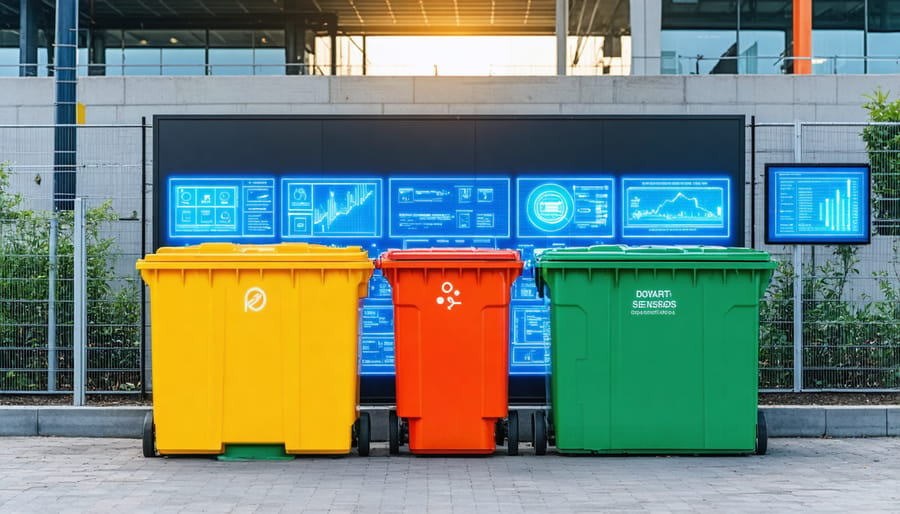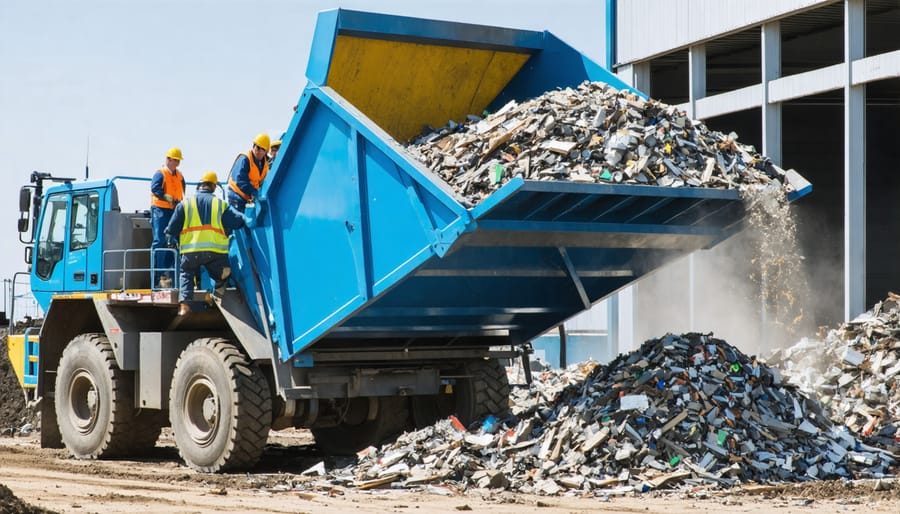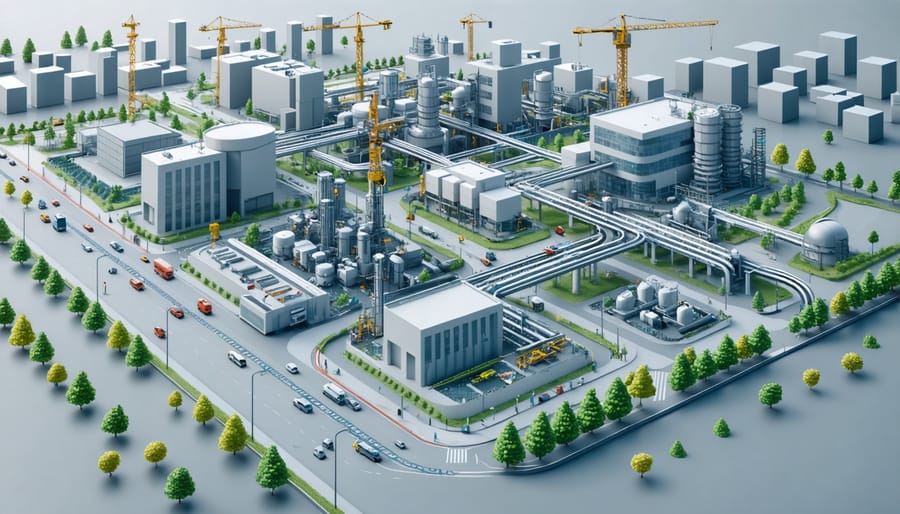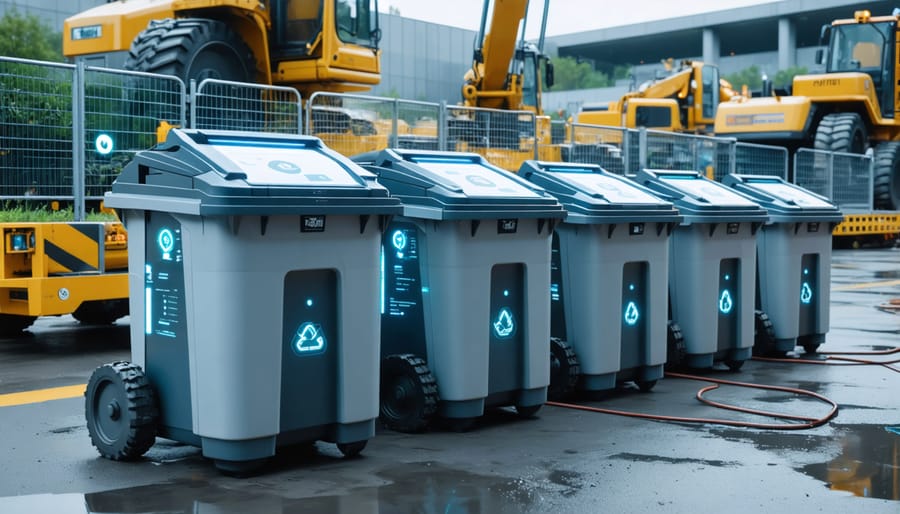Revolutionary waste management technologies are transforming how cities handle their municipal waste streams, with construction and demolition materials representing over 40% of global urban waste volume. Leading municipalities have achieved remarkable success through zero waste initiatives that integrate artificial intelligence, blockchain tracking, and advanced materials recovery facilities (MRFs).
Smart waste bins equipped with IoT sensors now optimize collection routes in real-time, reducing operational costs by up to 30% while minimizing vehicle emissions. Automated sorting systems using AI-powered robotics separate mixed waste streams with 99% accuracy, dramatically improving recycling rates and material recovery. These innovations, combined with distributed processing facilities strategically placed throughout urban centers, create a robust infrastructure capable of handling increasingly complex waste streams.
For construction professionals and urban planners, these advancements represent both a challenge and an opportunity. By implementing these technologies alongside circular economy principles, municipalities can transform waste management from a costly burden into a revenue-generating asset while significantly reducing environmental impact.
Digital Tracking Systems Transform Waste Management
Real-Time Waste Analytics
Real-time waste analytics has revolutionized municipal waste management through the strategic deployment of smart sensors and advanced data analysis systems. These IoT-enabled devices, installed throughout waste collection points, continuously monitor fill levels, waste composition, and collection patterns, enabling data-driven decision-making for resource allocation.
Smart sensors employ ultrasonic technology to measure waste volumes and weight sensors to determine container loads. This data streams to central management systems, where AI-powered analytics platforms process the information to optimize collection routes and schedules. According to recent industry studies, municipalities implementing these systems have reported up to 30% reduction in collection costs and significant improvements in service efficiency.
The analytics platform provides valuable insights through customizable dashboards, offering real-time visibility into waste generation patterns, peak disposal times, and potential system bottlenecks. This information enables waste management authorities to adjust services proactively, preventing overflow situations and maintaining optimal collection frequencies.
Case studies from major metropolitan areas demonstrate the transformative impact of these systems. For instance, Barcelona’s smart waste management program achieved a 40% improvement in collection efficiency through sensor-based monitoring and route optimization. The system also facilitates predictive maintenance of collection infrastructure, reducing downtime and extending equipment lifespan.
For construction professionals, these analytics systems offer particular value in monitoring construction waste volumes and ensuring compliance with municipal disposal regulations while optimizing removal schedules based on actual site needs.

Automated Sorting Technologies
Automated sorting technologies have revolutionized municipal waste management through the integration of artificial intelligence and advanced robotics. These systems employ multiple detection methods, including near-infrared spectroscopy (NIR), x-ray transmission, and AI-powered visual recognition to identify and separate different waste materials with unprecedented accuracy.
Modern sorting facilities utilize conveyor systems equipped with high-speed cameras and sensors that can process up to 10 tons of mixed waste per hour. AI algorithms analyze material characteristics in milliseconds, enabling robotic arms to sort items by composition, color, and size. These systems can distinguish between various plastics, metals, paper products, and organic materials with up to 99% accuracy.
Recent implementations in major urban centers have demonstrated significant improvements in recovery rates. For example, the Rotterdam waste management facility increased its material recovery by 45% after implementing AI-powered sorting systems. These technologies have also reduced operational costs by 30% while minimizing worker exposure to hazardous materials.
The integration of machine learning allows these systems to continuously improve their sorting accuracy through pattern recognition and real-time adaptation. As municipalities upgrade their waste management infrastructure, these automated solutions provide scalable, efficient alternatives to traditional manual sorting methods, contributing to higher recycling rates and reduced landfill dependency.
On-Site Processing Solutions

Mobile Recycling Units
Mobile recycling units represent a significant advancement in on-site waste processing, offering immediate transformation capabilities that reduce transportation costs and environmental impact. These portable systems can be deployed directly at construction sites or temporary waste collection points, processing materials where they accumulate.
Recent innovations in mobile recycling technology have produced units capable of processing multiple waste streams simultaneously. Advanced sorting mechanisms, utilizing artificial intelligence and optical recognition systems, can separate mixed construction debris with up to 95% accuracy. These units typically process between 10-15 tons of waste per hour, making them suitable for medium to large-scale projects.
Industry leaders like Metso Outotec and Rubble Master have developed hybrid-powered units that combine diesel and electric power sources, reducing operational costs by up to 30% compared to traditional diesel-only equipment. These units feature integrated dust suppression systems and noise reduction technology, making them suitable for urban environments.
Case study data from the Metropolitan Development Authority of Singapore demonstrates that mobile recycling units reduced waste transportation volume by 67% and lowered carbon emissions by 42% across their pilot program sites. The units’ ability to process materials on-site creates immediate opportunities for material reuse, particularly for concrete, wood, and metal waste streams.
Municipalities implementing these systems report significant cost savings in waste handling and transportation. The initial investment, while substantial, typically shows returns within 24-36 months through reduced disposal fees and material recovery value. Forward-thinking construction firms are increasingly incorporating these units into their sustainability strategies, recognizing their potential to transform waste management practices while meeting stringent environmental regulations.
Waste-to-Resource Conversion
Construction waste presents a significant opportunity for resource recovery through innovative conversion technologies. By implementing circular economy principles, the industry is transforming traditional waste streams into valuable building materials.
Concrete recycling technology has evolved significantly, with advanced crushing and screening systems capable of producing high-quality recycled aggregates that meet stringent construction standards. These materials can replace up to 30% of virgin aggregates in new concrete applications, reducing both waste and natural resource consumption.
Wood waste processing has also seen remarkable advancement through automated sorting systems that separate treated and untreated timber. Clean wood waste can be processed into engineered wood products or biomass fuel, while contaminated materials undergo specialized treatment for safe reuse.
Recent developments in mineral wool recovery have enabled the conversion of demolition insulation materials into new insulation products, maintaining up to 85% of the original material properties. Similarly, innovative gypsum board recycling systems can now process used drywall into powder suitable for manufacturing new boards, creating a closed-loop system.
Metal recovery technologies have become increasingly sophisticated, utilizing electromagnetic separation and eddy current systems to sort different metal types with unprecedented accuracy. This allows for direct reintegration of recovered metals into the manufacturing supply chain.
These technologies not only reduce landfill burden but also create economic opportunities through material recovery. Construction companies implementing these systems report average cost savings of 15-20% on material expenses while meeting sustainability targets.

Integration with Smart City Infrastructure
Connected Logistics Networks
Connected logistics networks revolutionize municipal waste management through intelligent routing systems and real-time fleet optimization. These smart networks integrate IoT sensors, GPS tracking, and advanced analytics to create dynamic collection routes that adapt to actual waste volumes and traffic conditions.
Fleet managers now utilize AI-powered platforms that process data from multiple sources, including bin fill-level sensors and historical collection patterns. This enables precise scheduling and route optimization, reducing fuel consumption by up to 30% and minimizing vehicle wear and tear. Real-time traffic analysis and predictive maintenance alerts further enhance operational efficiency.
Smart routing systems consider various factors such as vehicle capacity, waste type segregation, and transfer station locations to optimize collection schedules. By implementing dynamic routing, municipalities have reported significant reductions in collection times and operational costs.
A notable example is Stockholm’s waste management system, which implemented connected logistics networks in 2019. The city achieved a 20% reduction in collection vehicle movements and a 15% decrease in fuel consumption within the first year of implementation.
The integration of these systems with municipal waste facilities enables better resource allocation and improved response times to urgent collection needs. This interconnected approach ensures efficient waste handling while reducing environmental impact through optimized transportation routes and reduced emissions.
Municipal Data Integration
Modern municipalities are leveraging data integration systems to create a seamless connection between construction waste management and urban planning initiatives. By implementing IoT sensors and real-time monitoring systems at construction sites, cities can track waste generation patterns, optimize collection routes, and predict future disposal needs with remarkable accuracy.
These integrated systems enable construction managers to input waste data directly into municipal databases, creating a comprehensive overview of material flows throughout the city. Environmental monitoring stations correlate this information with air quality metrics, helping authorities identify potential environmental impacts and adjust waste management strategies accordingly.
Several leading cities have demonstrated the effectiveness of this approach. Copenhagen’s integrated waste management system has achieved a 25% reduction in construction waste transport costs through optimized routing and real-time capacity monitoring. Similarly, Singapore’s construction waste tracking platform has enabled better resource allocation and improved recycling rates by 30%.
The key to successful integration lies in standardized data protocols and interoperable systems. Construction companies can now use mobile applications to log waste quantities, types, and disposal methods, while municipal authorities gain instant access to this information for planning and compliance purposes. This digital ecosystem also facilitates better communication between stakeholders, enabling rapid response to potential issues and more efficient resource allocation.
As cities continue to grow, this data-driven approach becomes increasingly vital for sustainable urban development and effective waste management planning.
Sustainable Economic Models
Innovative municipal waste management requires sustainable economic models that balance environmental responsibility with financial viability. Leading municipalities are implementing resource management strategies that transform waste from a cost center into a revenue-generating opportunity.
Pay-as-you-throw (PAYT) systems have demonstrated remarkable success, reducing waste volume by up to 40% while generating consistent revenue streams. These programs incentivize waste reduction by charging residents based on the amount of waste they produce, rather than through flat fees. Implementation costs typically recover within two to three years through reduced disposal costs and increased recycling revenue.
Public-private partnerships (PPPs) are emerging as powerful vehicles for waste management innovation. These arrangements allow municipalities to leverage private sector expertise and capital while maintaining public oversight. Successful PPPs often incorporate performance-based contracts that align contractor incentives with waste reduction and recycling targets.
Material Recovery Facilities (MRFs) operating on circular economy principles are proving particularly profitable. Modern MRFs utilizing AI-powered sorting systems and robotics can process materials more efficiently, reducing operating costs by up to 30% while improving recovery rates. The sale of high-quality recyclable materials can offset facility operating costs and potentially generate surplus revenue.
Waste-to-energy facilities represent another economically viable model, particularly for non-recyclable materials. Advanced facilities can generate electricity while meeting strict environmental standards, creating multiple revenue streams through power sales and tipping fees. Initial capital costs are substantial, but operational profits typically manifest within 5-7 years.
The key to sustainable economic models lies in diversification of revenue streams and strategic integration of technology. Successful municipalities are combining multiple approaches, creating resilient systems that remain economically viable despite market fluctuations in recyclable material prices.
The implementation of innovative waste management solutions in municipal settings represents a significant leap forward in urban sustainability and resource efficiency. As demonstrated by numerous successful case studies, technologies like AI-powered sorting systems, smart bins, and automated waste collection have already begun transforming how cities handle their waste streams. These innovations have resulted in measurable improvements, with many municipalities reporting up to 40% reduction in landfill waste and 30% decrease in operational costs.
Looking ahead, the integration of IoT sensors, blockchain technology, and advanced analytics promises even more sophisticated waste management solutions. The construction industry, in particular, stands to benefit from these developments through improved material recovery rates and more efficient waste diversion processes. Industry experts project that by 2030, smart waste management systems could help cities achieve up to 70% waste recovery rates while significantly reducing their carbon footprint.
The success of these initiatives relies heavily on continued collaboration between municipal authorities, technology providers, and construction industry stakeholders. As cities worldwide face growing waste management challenges, the adoption of innovative solutions becomes not just an option but a necessity. The future of municipal waste management lies in embracing these technological advances while ensuring their integration with existing infrastructure and operational processes. This evolution will ultimately lead to more sustainable, cost-effective, and environmentally responsible waste management practices across urban environments.

